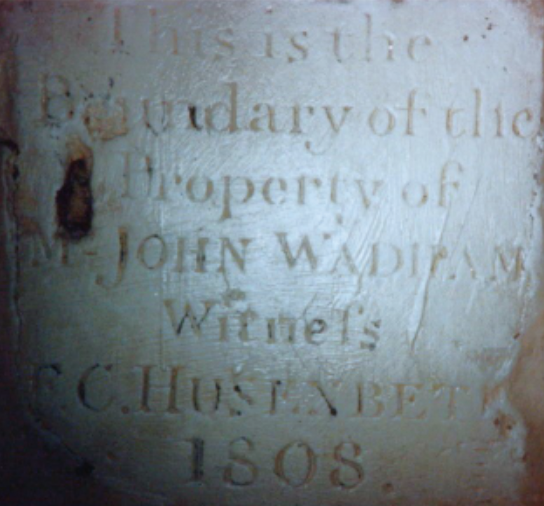Are you aware that there is a 19th century wall in central Bristol which contains a mystifying inscription: “Half this wall is the property of the Corporation of Bristol”? No explanation as to the ‘whys or wherefores’ or even which half, top bottom, or side. A covert property deal?
Intrigued, I made inquiries and was told the inscription originally accompanied a strange set of marks. Although not understood, these were copied and lodged with the City Archives. I had a fruitless search, but I wasn’t sure what I was looking for and didn’t know where it was filed.
After another two days in the archives I found the strange set of marks. Baffled, I consulted a friend who said it could be a Transpositional Cypher. Months went by, I’d forgotten all about it, when out of the blue he called. He thought it a ‘pigpen cypher’, and if correct was about an underground meeting and the message included the name Wadipam.
I could only find one person of that name in Bristol in 1808. A John Wadipam trading as a glazier, (very surprising considering the venue for his clandestine meeting), perhaps he had a secret fear of defenestration? Was he also responsible for another underground room off Bath Road which had a window blocked by earth?
So what was the venue of John Wadipam’s meeting, and what merited such extreme secrecy? When I was given a full transcription of the cypher, it was a very short message, “meet at Wadipam’s cellar”. I then discovered that John Wadipam had called upon Frederick Charles Husenbeth, a well-respected Bristol merchant with premises on St Nicholas Street, for his help resolve a long running property dispute. He was trading as Husenbeath and Co, of St Nicholas Street in 1795, and by 1806 the business expanded to Husenbeath and Son with a further business beneath the New Market in Baldwin Street, beside the ‘Market Steps’ leading to St Nicholas Street from Baldwin Street.
But where was the meeting to take place? Bristol still has thousands of cellars. At last, after newspaper publicity, a person who remained anonymous came forward with a faded photograph of a lettered stone in a cellar, explaining the outcome but not the dispute. We were then told of yet another mysterious inscription that had been recorded, this time in Fulthark Runes – a Scandi red herring to put people off the trail?
A runic message in Bristol, surely not! However Bristol did once have an exclusive Royal Licence to trade with Baltic States. We had it translated, hoping it would throw light on our riddle, but it merely read: “Man is but a heap of mouldering dust”. We finally gave up. However we did find another Scandinavian message on an iron plate set in the pavement near Lloyds Greengrocer’s on Henleaze Road, it memorialised the Danish invasion of the Southwest. It reads ‘Danelaw CATV’. Which obviously stands for: Conquerors Always Thinking of Valhalla.


